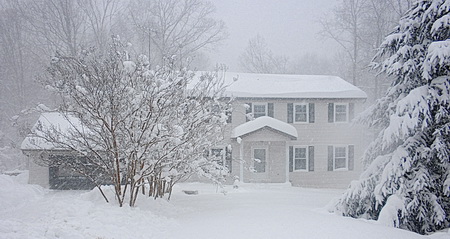
Winter Painting Questions Answered by Washington, DC Area Contractor
Who really wonders how paint dries? It seems like there couldn’t be a simpler – or more boring – process to understand. The paint is wet, you give it some time, and then it dries. End of story, right?
Wrong.
Painters and painting engineers who understand what it takes for paint to dry, deeply respect the process for its delicacy and intricacy. Believe it or not, an understanding of how paint dries, and the interruptions that render it vulnerable, goes a long way toward understanding why you can’t paint in the winter.
First of all, paint does a lot more than just dry. It forms a film, changing from a viscous liquid to a strong, extremely thin, solid. While you may not think much of it, a paint film is actually a miraculous creation, standing straight up and adhering to the surface as a perfect uninterrupted whole. The transition from the liquid in the can to the strong, durable film that we rely on for our architectural protection, is a carefully choreographed process.
Each type of paint – oil, alkyd, latex, epoxy, etc – forms a film in a different way. For the purpose of this discussion, we will focus on latex paints, because they are becoming the most commonly used in the painting market.
Latex paint, though you can’t tell with the naked eye, is a curious mixture of tiny beads of plastic suspended in water. The beads don’t mix with the water, because they are not water soluble – and they do not stick together when the paint is in its liquid form, because they are separated by a third component mixed into the paint: the surfactant. The surfactant is a soapy oil that thinly coats each bead of plastic, making it bounce harmlessly off of any other beads of plastic that it may encounter while in suspension.
The “drying” – or, more accurately, “film forming” of latex paint is a play with three acts. Act one: the water evaporates out of the film, leaving behind the surfactant-coated beads of plastic. Act two: the surfactant, without the water to provide resistance, bleed together and run or evaporate out of the film. Act three: the beads of plastic, now exposed to each other, bind together in a powerful chemical process known as coalescence. This process is not reversible: once the beads of latex have bonded, they become inseparable, and a strong film is formed.
Here is what happens when you try to apply latex paint to a surface when it is cold, or wet (like undertaking an exterior paint job in the Washington, DC winter). Act one gets skipped, because when it is too cold or to moist, the air is saturated and does not encourage evaporation. So the water stays in the paint film. The surfactants, since they are heavy and are now applied in a vertical film with constant gravity, start to bleed together and leach out of the paint job anyway. Since the surfactants are leaching, the beads of plastic come in contact and start to bond – but since the water is still present, they bond in uneven clumps, and do not adhere to the substrate. Ultimately, the film forms with wide unstable patches, and with inadequate adhesion, fails completely.
Due to our understanding of the physics of paint film formation, Blue Door Painters exterior painting season is from late March through early December: the times of year when you can at least hope the temperature in Washington DC will stay above 35 degrees and the humidity will stay low enough to encourage a successful paint job.